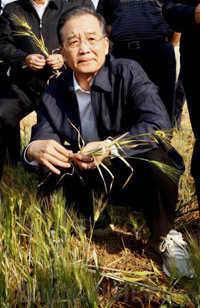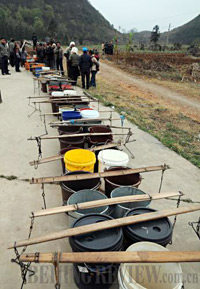|
 |
 |
|
CARING FOR PEOPLE: Premier Wen Jiabao checks the barley affected by drought at Shizikou Village of Luliang County, Yunnan Province, on March 19, during an inspection trip (YAO DAWEI) |
PRECIOUS GIFT: Villagers queue for water in Panxian County in Guizhou Province on March 13. The county has taken different measures to ease the shortages of drinking water for people (LU WENCHUN) |
The worst drought in about a century has turned much of south and southwest China into parched fields and dry rice paddies, with no drinking water for thirsty villagers.
After more than 200 days with hardly a drop of rain, the drought is affecting millions of people in Yunnan, Guizhou, Sichuan provinces, Guangxi Zhuang Autonomous Region and Chongqing Municipality, which represent 83 percent of drought-stricken areas across the country.
Since autumn last year, such drought-hit areas of China have received only half their annual average rainfall and water stores are depleted, China's State Commission of Disaster Relief (SCDR) said on March 19.
The drought had caused direct economic losses of 19 billion yuan ($2.78 billion) as of March 17 and nearly 1 million hectares of farmland has become unproductive.
Water shortage
The dangerous drought has resulted in a shortage of drinking water for millions of people and in livestock and crop failures.
As of March 17, the severe drought has affected 51 million people in south and southwest China, leaving more than 16 million people and 11 million livestock with drinking water shortages, the SCDR said.
About 4.35 million hectares of farmland were affected, the commission said.
Crop production in drought-hit areas will be reduced by 50 percent of last year's yield, said Zhang Yi, Director of the National Farming Technique Promotion Center of the Ministry of Agriculture.
On March 18, the Guizhou Provincial Government issued a drought alert, warning the dry period that started in July last year had seriously affected living conditions and calling for further anti-drought efforts.
The local civil affairs department said 86 of the 88 cities within the province are drought-hit regions, with 5.57 million people and more than 2 million livestock suffering from water shortages.
The disaster has cut irrigation for 830,000 hectares of farmland, including 28,947 hectares that are seriously affected.
Average precipitation in the province was 47.7 millimeters since December last year, half that in the same period in the previous year, the Flood Control and Drought Relief Headquarters of Guizhou said. Water inflow in some major rivers has dropped by 90 percent and water reserves in all reservoirs in the province dropped by about 32 percent.
In the neighboring Yunnan Province, the drought has left more than 7 million people short of drinking water. The drought has also affected more than 2 million hectares of farmland and threatened the water supply of more than 4 million livestock.
The amount of rainfall in Yunnan between September 2009 and March 2010 dropped about 60 percent compared with previous years, said Zhu Yong, Director of Yunnan Provincial Meteorological Center.
He said that the drought in some regions was the most serious in 100 years and would persist until mid-May.
As of March 18, all 77 counties and cities in Guangxi had been affected, and more than 2.2 million people and 1 million livestock are suffering from a lack of water. An area of 523,000 hectares of farmland has been affected.
The Meteorological Bureau of Guangxi said the rainfall in the region has decreased 20 percent, and the situation is not expected to improve in April.
The latest figures released by the Chongqing Municipal Flood Control and Drought Relief Office show the drought has left 940,000 people and 420,000 livestock suffering from a shortage of adequate drinking water and affected 180,000 hectares of farmland across the municipality.
Heavy rainfall for Chongqing is not expected until mid-April.
In Sichuan, the drought has affected more than 510,000 hectares of farmland, leaving more than 1.8 million people and more than 2.2 million livestock short of potable water, statistics from the Provincial Flood Control and Drought Relief Office show.
In efforts to help resolve drinking water crises, the Ministry of Water Resources and State Flood Control and Drought Relief Headquarters held emergency meetings to help drought-stricken provinces carry out water supply plans and water resource management.
The ministries of finance, agriculture, civil affairs and water resources have appropriated more than 370 million yuan ($54.4 million) to combat the drought.
The funds are to be used to purchase drinking water, equipment and supplies for urgent water construction projects.
More than 4,000 troops of the Chinese People's Armed Police Force (PAPF) in Sichuan, Guizhou, Yunnan, Guangxi and Chongqing have been mobilized to help rural residents with water supplies.
The PAPF detachment in Yunnan's Yuxi City has supplied more than 17 tons of its water reserve to 176 households in the province. In Sichuan, PAPF troops used their machinery to help pump underground water.
In Guangxi, PAPF troops transported water in trucks to 13 remote villages which are home to more than 7,000 farmers and 6,000 livestock.
The State Flood Control and Drought Relief Headquarters said local authorities in Yunnan, Guizhou and Guangxi had built 3,092 water diversion systems and 58,600 irrigation works, and dug 11,200 wells.
During a three-day trip to Yunnan on March 19-21, Chinese Premier Wen Jiabao called for "intensified and consistent efforts" to relieve the drought and help affected people overcome difficulties.
Other effects
The drought has also caused the prices of goods to soar, affecting much of the food chain, including vegetables, flowers, tea, herbs, fruit, rubber, sugar and grain.
"The total trading volume of flowers has decreased by 30 to 40 percent this spring, and the wholesale prices of flowers have jumped," said Zhang Li, Vice Manager of Kunming International Flower Auction Trading Center Co. in Yunnan, China's largest fresh flower production and export base.
The Yunnan Flower Association said about 31,000 hectares, or 80 percent of the province's total flower fields, were short of irrigation. About 10,853 hectares were damaged and 1,627 hectares did not deliver harvests.
The drought has incurred 854 million yuan ($125 million) in direct economic loss in the sector, statistics from the association show.
Yunnan provides nearly 80 percent of all fresh flower sales in the domestic market. Many cities across the country have reported nearly a 100-percent price rise and a remarkable drop in supplies this year.
The average wholesale price for a rose at Kunming's Dounan Flower Market, China's largest flower wholesale center, hit 2 yuan ($0.29) in the first two months of the year—double the price at the same period of last year.
In Beijing, the prices of flowers such as roses and lilies have risen by about 30 percent.
Yunnan's drought has also affected the price of the popular spring tea Pu'er, of which the province is the main growing and exporting base.
"The production of spring tea in Pu'er this year is expected to drop by 20-30 percent," said Li Shuyan, a local official in charge of the tea industry.
The drought has impacted 200,000 hectares of tea-growing land, which account for 60 percent of the total in the province, the Kunming-based Yunnan Information Daily reported on March 18.
Official figures show wholesale prices for Class-A tea at the Chayuan Palace Tea Distribution Center have reached 50-65 yuan ($7.32- $9.52) per kg, up by 8-10 yuan ($1.17-$1.46) over the previous year.
In addition, drought also poses a threat to tourism development.
In Guangxi's Guilin, a most popular tourist attraction, the Lijiang River is suffering from its lowest water level in recent memory, forcing tourism companies to cancel more than half of the regular sightseeing boat rides on the river, China National Radio said on March 18.
In Guizhou's Anshun, the Huangguoshu Waterfall, also known as Yellow Fruit Waterfall, the largest waterfall in China and in all of Asia, is facing the worst water scarcity in its history as the city is hit by a severe drought that has dried up 90 percent of the city's rivers and reservoirs.
The water volume of the waterfall has plunged 75 percent compared to its regular levels, said the Huangguoshu Tourism Co. Ltd., which runs the waterfall.
The drought also has put a damper on the Dai people in Yunnan, who have been asked to use water sprayers instead of buckets to drench each other during their annual Water Splashing Festival on April 13-16.
Facts and Figures
As of March 23, drought affected 7.6 million hectares of farmland nationwide. More than 22.7 million people were short of drinking water across the country.
Yunnan
About 7.42 million people and 4.86 million livestock were thirsting for rain; more than 2 million hectares of planted crops were affected.
Direct agricultural economic losses reached 17 billion yuan ($2.5 billion).
Guizhou
Some 5.57 million people suffered a shortage of drinking water. About 830,000 hectares of farmland, accounting for 60 percent of the summer harvest, were affected.
Direct agricultural economic losses were more than 2.8 billion yuan ($410 million).
Sichuan
About 8.29 million people were affected and 1.85 million of them lacked drinking water. More than 510,000 hectares of farmland were affected.
Direct agricultural economic losses were 1.38 billion yuan ($202 million).
Guangxi
A total of 2.19 million people and 1.11 million livestock were short of drinking water; 751,000 hectares of farmland in all the cities and counties of the autonomous region were affected.
Direct agricultural economic losses were 466 million yuan ($68.22 million).
Chongqing
About 940,000 people and 420,000 livestock were short of drinking water.
More than 180,000 hectares of farmland were affected.
(Source: Xinhua News Agency) | 